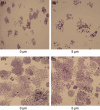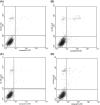Frequent hypermethylation and loss of heterozygosity of the testis derived transcript gene in ovarian cancer
- PMID: 20180808
- PMCID: PMC11159749
- DOI: 10.1111/j.1349-7006.2010.01497.x
Frequent hypermethylation and loss of heterozygosity of the testis derived transcript gene in ovarian cancer
Abstract
Testis derived transcript (TES) is a candidate tumor suppressor gene located at the human chromosome 7q31, and its function in ovarian cancer is still unknown. Using ovarian cancer cell lines and tissue samples, we demonstrated that both loss of heterozygosity and hypermethylation of the TES gene occurred in ovarian cancer at high frequencies, and there were significant correlations between TES expression and hypermethylation or loss of heterozygosity. We also detected methylation in ovarian cancer cell line A2780 after treatment with 5-aza-2-deoxycytidine. The expression level of TES was enormously up-regulated, then caused changes to the biological behaviors of A2780 cells: cell growth properties were greatly impaired, colony formatting abilities were suppressed to very low levels, and the apoptosis rate was highly raised compared to the control group. Our findings suggest that the TES gene functions as a tumor suppressor gene and is frequently silenced by hypermethylation and loss of heterozygosity in ovarian cancers.
Figures








References
-
- Aguiar RC, Dahia PL, Sill H, Toledo SP, Goldman JM, Cross NC. Deletion analysis of the p16 tumour suppressor gene in phaeochromocytomas. Clin Endocrinol (Oxf) 1996; 45: 93–6. - PubMed
-
- Callahan R, Cropp C, Sheng ZM et al. Definition of regions of the human genome affected by loss of heterozygosity in primary human breast tumors. J Cell Biochem Suppl 1993; 17G: 167–72. - PubMed
-
- Brown MR, Chuaqui R, Vocke CD et al. Allelic loss on chromosome arm 8p: analysis of sporadic epithelial ovarian tumors. Gynecol Oncol 1999; 74: 98–102. - PubMed
Publication types
MeSH terms
Substances
LinkOut - more resources
Full Text Sources
Medical

